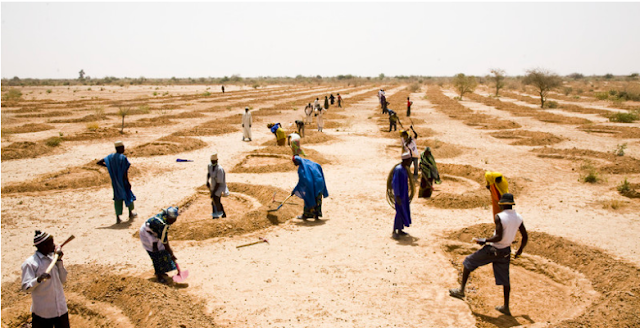What is Water Scarcity, is Africa Really Water Scarce?
UN
DEVELOPMENT GOALS:
'[…to]
substantially reduce the number of people suffering from water scarcity by 2030.'
WHAT IS WATER SCARCITY, IS AFRICA REALLY WATER SCARCE?
In
this post I will discuss and define water scarcity, by comparing two commonly
used measurements. I then observe recent rainfall patterns across Africa and
attempt to identify gaps in relation to rainfall increase and water scarcity.
Water
security is a topic that is prominent in global political conversation. It
serves as a starting point for dialogue particularly from organisations such as
UN-water, IMF and the World Bank.
The
infographic below highlights the main elements of water security.
Much
of the discussion around water security centres itself around Africa, with Sub-Saharan Africa having the largest
number of 'water-stressed' countries of any region.
Water
stress 'occurs when , 2012 the demand for water exceeds the available amount
during a certain period or when poor quality restricts its use' (European
Environment Agency, 2017).
Water
scarcity is defined as a 'shortage of renewable freshwater water relative to
demand' (Taylor, 2009). It is contested in its definition and measurements,
thus leading to further confusion on who is actually in need of a water
scarcity alleviation.
A standardised measure of water scarcity is
needed for terms so often thrown about by the media and international
organisations. The figure below demonstrates the issues with multiple
measurement indexes for water scarcity, producing varying results of how severe
the problem is (White, 2012).
FIGURE
1:
Results
of different water indexes on the threat to human water security, focusing on
Africa (Vorosmarty et al. 2010).
A comparison of two
measurements:
- Water Stress Index (WSI) - Fallenmark and Lindh (1974)
Fallenmark
presents a fairly straightforward approach to defining water scarcity,
explicitly linking food security to fresh water availability (Fallenmark, 1986,
1989). Water scarcity Index is measured in terms of the number of people sustained by a single flow unit of water.
Fallenmark
provided a summary of thresholds within the WSI to help segregate regions in
severity of water for each person. This stretched from:
No
stress: <600 people/ flow unit
Water
scarcity: 600–1000 people/flow unit
Water
stress: 1000–2000 people/flow unit
Absolute
water stress: >2000 people/flow unit
(Flow unit of water - defined as 106 m3year−1.)
Limitations:
Only measured at country level, therefore does not
recognise regional differences in water availability.
It includes water resources such as groundwater, that may be
un-accessible.
- Water poverty Index (WPI) - Sullivan, 2003
This
index differs in that it measures water stress at household and community
levels (Sullivan et. Al, 2003). It aimed to specifically highlight the links
between poverty reduction and water availability (Taylor et. Al, 2017). The WPI
is a step in the right direction, seeking to empower poorer populations in
assisting decision making that determines interventions in the water sector,
which has the greatest effect on their provisions of water access.
It
highlights that people can be 'water poor' if they are income poor', as they
cannot afford to purchase the clean water that is available (Lawrence et. Al,
2002).
Within
this index, the following components are:
Resources
Access
Capacity
Use
Environment
Recent Rainfall Patterns:
Changes
in distribution of extreme precipitation patterns have been observed across
many parts of Africa, most of which can be linked to climate change and
variability. Arid and semi-arid regions pose a threat to desertification of
many regions, this can have severe impacts on vegetation, a high cost for many
African countries that rely on low-productive, rain-fed agriculture (Below et
al, 2007).
Significant
declines in internal rainfall trends in tropical regions such as, The
Democratic Republic of Congo and Equatorial Guinea have been observed (Hoscillo
et. Al, 2014).
Adversely,
opposing common perceptions, a proportion of regions in Africa are
actually getting wetter. Data produced by the Climate Prediction Centre and the National
Oceanic and Atmospheric Administration (NOAA) reveals that over the last
decade, a drastic increase in the amount of rainfall across Africa has been
observed (Fitch, 2015). Central Sahel, Senegal, Western Guinea and Mauritania
are significantly wetter than the previous decade.
FIGURE
2:
'Trend in rainfall over ten years. Blue =
Wetter conditions, red = drier conditions' (Hoscilo et Al, 2014).
Distribution of water
My
immediate thought is, if parts of Africa are increasing in precipitation, why
are many countries considered water scarce?
One
of the main issues is uneven distribution of water. This can be effected by
many things including:
Governance
Accessibility
Affordability
Bibliography
Below R, Grover‐Kopec E, Dilley M. 2007. Documenting
drought‐related disasters. J. Environ. Dev.
European Environment
Agency, 2017. 'Water Stress'.
Fallenmark, M. 1986.
'Fresh water-time for a modified approach.'
Fitch, C. 2015. 'New African Rainfall Patterns'.
Lawrence, P. Meigh,
J. Sullivan, C. 2002. 'The Water Poverty Index:
an international comparison.' Keele Economics Research Paper
Sullivan, C. Meigh,
J R. Giacomello. 2003. 'The Water Poverty Index: Development and application at
the community scale'.
Taylor, R. Damkjaer.
S. 2017. 'The measurement of water scarcity:
Defining a meaningful indicator.'
White, C.. 2012. 'Understanding water scarcity: Definitions and
measurements.' Australian National University.
Figure 1: Vorosmarty, C.J., et al., 2010.
‘Global threats to human water security and river biodiversity’, Nature,
467:555–61.
Figure 2: Hoscilo, A. Balzter, H. Bartholomé, E. Boschetti, M.
Brivio, P. Brink, A. Clerici, M and Pekel,F






This post engages well with the "water scarcity" debate over metrics and, critically, their application to the context of Sub-Saharan Africa. It is interesting to see the description of the Water Poverty Index - what are thoughts on its computation? What assumptions inform the assertions that many countries in Africa are "water-scarce"?
ReplyDelete